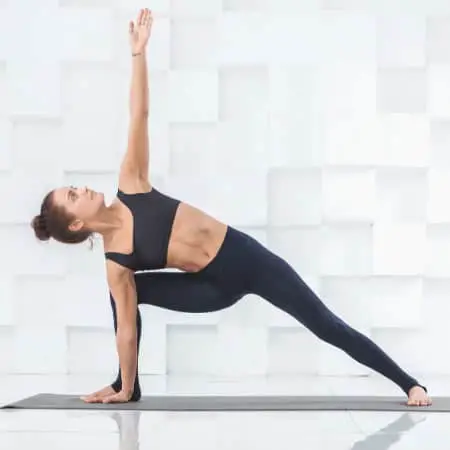Yoga, on the outside, can appear to be a very calm and serene activity. For those who have never tried yoga before, they might find it hard to imagine that this peaceful-appearing practice can induce deep muscle aches. However, those who have tried their first class may be left wondering how they can be feeling this sore.
Yoga should make you sore after practice, especially if you are a beginner, as it targets muscles in uncommon ways. But as you develop your practice and understand how to listen to your body, you will learn to accept and honor your physical edge, avoiding intense soreness after the fact.
Let’s explore why yoga can make you sore and what you can do to tune into your body during your practice. We will also take a few tips for tending to sore muscles and how to help your body heal as efficiently as possible post-practice.
For Beginners: How To Approach the Practice
If you have just attended one of your first yoga classes and are now sore in places you did not even know you had muscles, you are certainly not alone. One of the reasons yoga feels so amazing is also why it can make beginners feel so sore.
This is because yoga moves and stretches muscles not commonly used in regular life or many other common sports. Therefore, if you are a sporty and physically active person, you may be surprised by how sore you can feel after the first class. This soreness has to do because physically, you move in new ways and hold these strange new shapes for several breaths.
However, it is not just the physical aspect that can cause soreness. Mindset can have an impact as well.
A New Mindset
In most other sports, you are trained to do your best, push yourself, and achieve results. This type of mindset is not uncommon in other parts of society, as well. Often workplaces will value this type of attitude as well. If you are excited about yoga, it is natural that you would come to your first class ready to try your best. This may mean that you would be prepared to push yourself and try to achieve each pose’s shape the best that you can.
However, yoga is not just using your body in ways you are not used to; it also requires that you start to use your mind in ways you are not used to as well. Yoga is not about achieving poses or shapes, pushing yourself to an external standard, or being in competition with anyone- even yourself.
Yoga is a chance to be present. It is a chance to let the thinking mind go quiet. It is a chance to notice your breath. It is a chance to slowly and deeply move your body and in alignment, but not to push it beyond what it can do that day. Yoga is about honoring and accepting the body as it is right now. It will be different tomorrow the same way it was different yesterday. It is also about being present while quieting the mind in order to listen to the body.
Begin To Practice Both Poses and Mindset
As beginners go through the mental shift required of yogis, there may be a time at the beginning where they are still tempted to push themselves. Because of these mental and physical reasons, beginners are much more at risk of over engaging physically and ending up sore the next day.
However, if this is you, there is nothing to feel bad about. This is part of the journey when it comes to practicing yoga. As you go forward, remember that instead of pushing yourself, you can try accepting yourself. Practice staying with your breath as opposed to pushing your body further than it is ready to go. As your body opens and you learn to guide it gently, you will notice your soreness greatly reducing as you respect your limits.
What the Soreness Is Telling You
Even as your body opens and your mindset shifts, it is still common for everyone to experience a bit of soreness from time to time. Luckily, it will probably be more isolated and less intense than the whole-body, intense soreness many of us experience initially. As you develop in your practice, you can consider the question: what is this soreness trying to tell me?
The Body’s Response

When you engage in any form of exercise, you contract your muscles in ways beyond what is usually called for daily life. As your muscles perform these contractions, whether it be by holding yoga poses or other exercises, they are being broken down on a minute scale. The contractions cause microscopic tears in the muscles.
When thinking of something being torn away and broken down, we usually do not think of making something stronger. But that is exactly how it works when it comes to muscle building and strengthening. As you use your muscles and cause these microscopic tears, you trigger an essential bodily function that will help you become stronger in the long term. This function is the body’s inflammatory response.
When the inflammatory response is activated, the body pays special attention to the muscles that were used in the exercise. In order to heal the microscopic tears, blood vessels must expand and allow blood to flow to the affected area. By the end of this healing process, the muscle will be built up larger and stronger than before.
Delayed Onset Muscle Soreness
The soreness you can feel at different times in this process is called Delayed Onset Muscle Soreness or DOMS. You can use how you feel at this time to understand your body more intimately. By tuning into which parts of your body are experiencing this tenderness, you will be able to gather information about how your different muscle groups are reacting to your yoga practice.
If you try a new pose and feel soreness related to it the following day, you could consider gently continuing to practice this pose regularly. This practice could help you build some underdeveloped muscles revealed to you by this new pose. Regular and gentle practice will help you strengthen a target area and bring more overall balance to your body and practice.
Coming Back After a Break
Even if you have been practicing yoga for many years, taking an extended break from the practice will impact your body. When you get back on the mat after several weeks or several months off, move gently into the practice, taking extra care to notice how your body is feeling at that moment.
It can be tempting to want to jump in where you left off, assuming your body can do everything it could do the last time that you practiced. While, of course, you will be back to this place with a little bit of patience, remember to honor where your body is today. Give yourself permission to gently ease yourself back into the practice. This gradual progression will help you build back up to where you were while avoiding unnecessary strain and soreness.
Hot Yoga
Hot yoga is extremely popular these days and can be found in many forms all over the country and across the globe. The extreme heat at which you practice can have a variety of health benefits. There are dedicated hot yogis that swear by its healing power and detoxifying properties. However, if you are new to the practice, be particularly careful not to overextend yourself to avoid extreme soreness and even injury.
What happens in hot yoga is that your muscles have the added benefit of being warmed by both your movement and the environment itself. We have probably experienced how it is easier to move after completing a warmup than moving first in the morning. Now imagine how much more flexible the body can feel as you warm up with asanas in sauna-like heat.
You may be excited by your new-found flexibility, but the downside is that you may end up over-stretching your body. It may not feel like you are pushing yourself because it does not feel so strenuous in the heat. However, this can be a misleading feeling. It is easy to overstretch in hot yoga and end up feeling incredibly sore the next day.
What To Do When You Feel Sore
While the good side is you know you are getting stronger, it is still usually not much fun to experience the delayed soreness after an intense workout or an unfamiliar yoga routine. How can you help your body heal faster? How can you make the pain feel less intense? Let us take a look at a few tips below.
Hydrate

After you finish your yoga practice, your body may be craving water. Make sure to satisfy this craving and keep drinking water in the hours after your practice. There are several reasons this is important for your body.
First, as we know from how the DOMS process works, blood needs to flow to the muscles in order to heal them. In order to allow blood to flow easily, drinking plenty of water will help raise our blood volume. This increase helps it move more easily throughout your body, getting to where it needs to go to start the healing process.
Second, drinking plenty of water post-exercise is a great way to flush out toxins that were recently released. In addition to any metabolic waste, these toxins can add to the feeling of soreness you experience.
One last piece of advice when it comes to hydration: keep it to plain water. While there are many flashy sports drinks and supplements on the market, keep it essential with fresh, clean water. This way, you are free to consume as much as you crave without worrying about added sugars, colors, and other ingredients found in many sports drinks.
Prioritize Sleep
A few hours after your yoga class, you might be more than ready for a good night’s sleep. It is not just that yoga can help us fall asleep more easily, but your body will also be craving the way it functions when allowed to sleep deeply.
When you allow yourself to get a full night’s sleep, you allow your body’s parasympathetic nervous system to take over. This system is known as the “rest and digest” function of the body, which stands in contrast to the “fight or flight” mode we can find ourselves during stressful moments of the day.
We are not easily able to perform deep healing when we are in a constant state of fight or flight, so it is necessary to give the body enough time in its other state. With sufficient time spent in the rest and digest mode, your body will be able to activate the functions necessary to deeply heal the parts of your body that need it most.
Eat a Nourishing Meal

When it comes to a post-yoga meal, make sure you take the time to eat something fresh, balanced, and nourishing. As you continue to practice yoga, you may find yourself craving more healthy, nutritious foods. That is no coincidence. Yoga helps us connect our body and mind, so it becomes easier to understand what the body is truly needing to make it feel good.
In order to give your body everything, it needs to speed up its recovery; aim for your meal to contain three elements: carbohydrates, proteins, and healthy fats. If you are vegetarian, there are many plant-based ways to get proteins. These do not have to be processed, specialty items like tofu or seitan either. You can find plenty of protein in lentils, beans, and even vegetables.
Protein is essential because this is what will help feed muscle growth and strengthening. Carbohydrates are necessary because they will help you feel refueled after depleting your energy in class. They will also contribute to a speedy and complete recovery.
Avoid Pain Medication
If you are tempted to take one or two over the counter pain medicines to relieve the soreness, try to resist this urge. The reason for this is that these are typically “anti-inflammatory” medicines. This type of medicine will be acting against the body’s natural process of inflaming the site that needs healing.
By taking medicine like this, you will be getting in your own way of feeling better. Your body is equipped to heal you naturally, and it is an excellent time to step back and let your body take care of itself.
Move Gently
You may be tempted to lay on the couch without much movement when your muscles are so sore. However, it is best that you keep moving, gently and easily. You can warm yourself by taking a walk or engaging in another activity that gently uses your body in a way you are accustomed to. When you are warmed up, performing some light stretches that target your sore areas can help release some of the tension you are feeling.
Remember that your body areas that are sore are the areas of your body that will need more attention. Do not avoid asanas or movements in the future that target these areas. Instead, bring your attention to these areas as you practice and help guide yourself to an overall stronger, more balanced body.
Soak in Warm Water
A warm bath when you have a body full of sore muscles can feel heavenly. The heat of the water will gently warm them, so you are able to move easier and experience some relief from the pain of soreness. It also helps you to relax, allowing your parasympathetic nervous system to take over and begin the deep healing process.
Soreness Versus Pain

All of this advice pertains to regular muscle soreness, not acute pain from an injury. If you have suspected something wrong goes beyond your body’s natural rebuilding, it is best to see a doctor.
This advice goes for during your practice as well. If you are practicing and experience sudden pain, it is best to stop immediately. Perhaps it will pass quickly, and you can return to your practice. However, if it does not, it is important to listen to your body, honor your current experience, and seek medical help.
Injuries often occur in yoga when we ignore what the body tells us and pursue what our mind is committed to achieving. The more you can practice being in alignment with how the body feels, the more you will be able to guide yourself in a sustainable, safe, and healthy practice.
Final Thoughts
With this more in-depth understanding of when and why our bodies can feel sore after yoga, we can better understand what we feel and respond appropriately. The more we can tune into our body’s messages, the more we can live in harmony with our true selves. The soreness you experience in yoga can be another way to learn to listen to and understand your own body.








